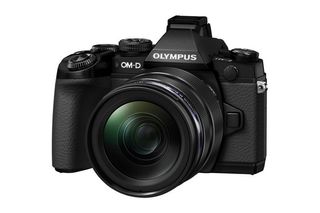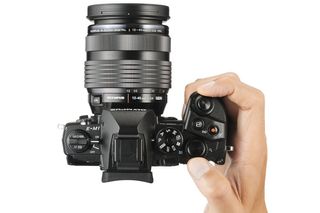Olympus OM-D EM-1 Review: All-Weather Champ
This Olympus OM-D EM-1 Review is a premium weatherproof mirrorless camera that has nearly all the features of an advanced DSLR.
Why you can trust Tom's Guide

With the success of its first retro-rugged mirrorless camera, the OM-D EM-5, Olympus took a winning solution and added even more features to create a flagship mirrorless camera with many of the functions found on larger DSLRs. The $1,300 (body only) EM-1 puts a 16-megapixel sensor and a multitude of controls in a weatherproof magnesium-alloy design. This allows the EM-1 to create professional-quality photos, without the waistline of larger DSLRs. Read on to see if the EM-1 could make you join the growing number of mirrorless converts.
Design: Handy LCD and viewfinder
The Olympus OM-D EM-1 packs a lot of functionality into its water-resistant magnesium case. Sections on the front and grip are textured with vinyl inserts. While the grip isn't as large as those found on larger DSLRs, the camera was still comfortable to hold and use, even in damp and drizzly weather.

The svelte, 1.1-pound body features a gorgeous 2.36M-dot, 1024 x 768 electronic viewfinder (EVF). Olympus also equipped the OM-D EM-1 with a 3-inch tiltable LCD touch screen for checking settings, shooting photos with a tap on the screen, or looking down to compose photos on the down low. I loved the ability to see the histogram in the EVF, giving me additional information when looking for perfect exposure in manual mode.
MORE: Best Mirrorless Cameras
Image Quality
Olympus packs the EM-1 with the company's 16 megapixel Live Mos sensor, Olympus' version of the CMOS sensor technology found in nearly all cameras these days. Top-notch specs include a max shutter speed of 1/8000 second, 10 fps sequential (burst) shooting and a max light sensitivity of ISO 25,600. The new TruePic VII image processor delivers strong image quality, although this is still mostly a daytime camera; image quality starts to deteriorate above ISO 3,200.
We tested the camera using the M.Zuiko 25mm f1.8 prime lens, which has a full-frame equivalence of 50mm. I captured images simultaneously as JPEG and uncompressed RAW files so I could evaluate both the raw capability of the camera and how it processes photos.
Daylight
The EM-1 shines in bright-light conditions. Colors are generally accurate, and most JPEG photos were pleasing straight out of the camera. Post-process editing is just a cherry on top. Color saturation was good, with a depth of color equal or better than other enthusiast's mirrorless and DSLR cameras. The blazing 10 fps sequential shooting is a testament to the power of high-end mirrorless cameras. It's faster than similarly priced Canon and Nikon DSLRs, which top out at 8 fps. I really enjoyed the speed of the autofocus system for capturing action photos.
(Click on any of the sample photos to see a larger version.)

The reds, oranges and yellows of these peaches I shot at a farmers market are bright and detailed, with the peach fuzz standing out when I zoomed in to 100 percent. The multi-pattern light metering (which considers the entire frame) helped keep the dark areas from losing detail. Comparing JPEGs to RAW, I didn't notice a great amount of difference, so for most occasions, smaller JPEGS will do just fine.

Even in direct sunlight, the EM-1 produced vibrant reds. Both the deep red currants and lighter strawberries look fresh and juicy, while even the bright white in the tablecloth is not overexposed.

In a portrait at Union Square Park in Manhattan, the EM-1 accurately captured the man's dark skin tone, while also preserving detail throughout. His white hair, which may have been overexposed with lesser cameras, was sharp and detailed, making for a striking contrast with his espresso complexion.

This park scene captures a wide dynamic range, from the direct sun along the path to the changing light as the path leads away into thicker coverage by tree branches. Focus is sharp throughout at f11, and all the different greens stood out even without the use of the included vivid image mode.
MORE: How to Take Great Pictures with Your DSLR or Mirrorless Camera
Low Light
In darker lighting situations, the EM-1 performs very well up to ISO 3,200. It should be noted that when set to auto, the EM-1 is hesitant to raise the ISO above 1,600 even in very dark conditions. This can cause photos to be underexposed, especially in more-challenging low-light situations. I often had a better experience in low light by manually switching between ISO 1,600 and 3,200 as necessary. I was also impressed with the EM-1 auto white balance.

Our photo of a flower stand at night displayed the EM-1's ability to accurately capture a wide range of colors, even with the harsh fluorescent lighting and auto white balance. While the white flowers in the back are on the verge of being blown out, the EM-1 shows strong dynamic range by preserving details in the darker buckets along the bottom of the photo.

Restaurant Week at Les Halles gave me a chance to capture a delicious meal in low-light conditions. At ISO 3,200, photo grain was noticeable, but not distracting. I would say the fine grain is even a little pleasing artistically. Shooting at a wide aperture of f2.8, which I needed for the low light, produced a very shallow depth of field. However, details are sharp at the point of focus on the crispy fries.The auto white balance was also very effective. Many other cameras would show more of a yellow cast when shooting inside.

Above ISO 6,400 goes into the EM-1's extended low-light range up to a max of ISO 25,600. At 6,400, grain starts to become much more noticeable. Shots are still useable, but after that, image quality begins to decrease quickly. Focus on the tall grapefruit perfume bottle is sharp, with grain in the lighter areas slightly more visible than the rest.
Video Performance: Unimpressive
In contrast to its prodigious still-photo ability, the Olympus delivered mediocre video performance. The EM-1 is limited to a max of 30 fps for movies, instead of the more common 60 fps clips seen on other high-end mirrorless cameras. On the bright side, the camera can monitor audio levels and comes with a jack for an external mic.
The EM-1 also suffers from the same shutter roll that plagues mirrorless and DSLR cameras. This can cause subjects in videos to appear stretched or distorted, especially in fast action shots. Video modes include program, aperture priority, shutter priority and full manual, giving you the ability to change settings midrecording.
Bright-Light Video
Although video is not the primary focus of the EM-1, movies shot in bright light still looked good. Our clip of musicians inside the subway station came out sharp, and unlike with low-light shots, the continuous autofocus was not distracted by fast moving objects passing through the foreground. Audio was also clear and rich, despite the poor acoustics of the New York subway.
Low-Light Video
Weak face-detection hurts the EM-1 in low light. The camera has a hard time recognizing subjects in anything less than close shots under ideal conditions. In our video of a baseball player warming up before an at-bat, the continuous AF on the EM-1 struggled to maintain a constant focus, and shifted from face to bat repeatedly.
Autofocus and Speed: Zippy
The autofocus on the Olympus is blisteringly fast. The EM-1 uses an autofocus system called "Dual Fast AF" that can use either contrast detection or on-chip phase detection (matching the ability of a DSLR). Even in low-light conditions, the camera performed fairly well. The continuous focus can actually be too fast at times, switching subjects between photos even when using the 6 fps low-speed sequential mode. This means when using continuous focus, you can lose sharpness on your intended subject, especially in fast-moving scenarios.
The OM-D EM-1 offers five different focus modes: single, continuous, manual, single plus manual and continuous plus manual.
The EM-1 starts up very quickly; it can be ready to shoot in less than a second. It also features impressive sequential photo speeds of 10 fps, capturing both RAW and JPEG files simultaneously. I noticed that when the camera was set to take JPEGs plus RAWS, I often had to wait 10-15 seconds to view my photos, even with just a 3- or 4-shot burst.
MORE: Tom’s Guide Digital Camera Glossary
Controls: Confusing at first
At first glance, the number of buttons and controls the OM-D EM-1 offers seems daunting. What Olympus calls its 2 x 2 control scheme has a steeper learning curve than many other cameras do. But after figuring your way around, you can see that the most important settings are never more than a few button presses away.

The two-position lever to the right of the viewfinder allows you to toggle all the controls to take on a new role. For example, with the lever in one position, the front dial controls shutter speed. Flip the lever, and that dial now controls ISO light sensitivity. Users can also change most controls using the touch screen.

The dials and wheels are tight, but easy to adjust without taking your eye away from the EVF. Most controls are customizable, as well. Although it just takes a flip of the toggle to switch the front wheel from shutter to ISO control, I found it handier to designate the programmable Fn1 button to the top right of the D-pad to be my dedicated ISO control. It may take a while to set up this camera and get used to it, but in the end, you are rewarded by the ability to make lightning-fast adjustments.
Our table below shows the number of button presses need to access commonly adjusted settings. Olympus fares well due to the sheer number of buttons.
| Setting | Presses to access | Function |
| Shutter | 0* | Length of exposure |
| Aperture | 0* | Amount of light let in |
| ISO | 2 | Light sensitivity |
| Focus mode | 1 | Point or points used for focus |
| Light metering | 1 | Part of image with optimized exposure |
| Custom white balance | 1 | Tune overall color cast of image |
| Exposure compensation | 1 | Set auto exposure to be darker or lighter |
| Wi-Fi sharing | 1 (touch icon) | Send images to smartphone, activate remote viewfinder |
| Video recording | 1 | Switch from photo to video and back |
| Play | 1 | View images or videos you've shot |
| Delete image | 1 | Remove image from card |
| Photo capture quality and resolution | 2 (1 button, 1 touch) | Amount of JPEG compression/detail, or RAW |
| Video capture quality | 4 | Resolution, frame rate and amount of compression/detail |
| Drive | 1 | Single photo, burst, timer, etc. |
Wireless: A bit glitchy
The OM-D EM-1 features a built-in Wi-Fi hotspot for connecting to a smartphone using the Olympus Share app (iOS and Android). This enables the camera to wirelessly transfer images to a smartphone and even use the phone's GPS capability to geotag image files. Simple photo editing is also included.
The app allows wireless shooting (though with a bit of a lag) and the ability to change settings for Shutter speed, Aperture, ISO, White Balance and shooting rate. You can also use touch focus, tapping the smartphone display at the exact spot you want just as you would the camera's own touch screen.
Connecting to the camera via the Share proved difficult. For setup, the camera displays a QR code on its LCD that you can scan with your smartphone camera to automatically connect. But when I tested this feature with a number of Android and iOS phones, I was rarely able to connect on the first attempt. I often had better success entering the Wi-Fi password manually.
MORE: Canon EOS Rebel T5 Review: Good for Beginners
Battery Life: A bit short
The EM-1's BLN-1 Li-ion battery has a CIPA rating of 350 shots. In theory, this should be more than enough, but I noticed that oftentimes the battery ran low earlier than expected. More than once over the review period I went out with two-thirds battery charge and ended up coming home early after fewer than 200 shots. Going out with anything less than a full charge can end in a shortened day of shooting. I suspect that the EVF and 3-inch screen are quite power hungry.
Thankfully, the battery recharges quickly, reaching full power (after complete discharge) in less than an hour. This means you can make a quick recharge at a nearby coffee shop.
Lenses: Great selection
The OM-D EM-1 uses the standard Micro Four Thirds mount, giving it a wide range of lens options. It can also accept Four Thirds lenses (meant for DSLRs), with an adapter (which downgrades the autofocus system from 81 points to just 37).

The Olympus 25mm f1.8 we used provides a great fast lens to start out with, and the $149 40-150mm f4.0-5.6 provides another inexpensive choice when you need a little extra zoom.
There are 21 lenses available on the Olympus site, including the M.Zuiko 25mm f1.8 prime lens we used during testing. Lenses range in price from $150 for the 40-150mm f4.0-5.6 M.Zuiko lens to $1,000 for the M.Zuiko 12-40mm f2.8. Any of Panasonic's20 Micro Four Thirds lenses, as well as models from third parties such as Sigma and Tamron, will also fit the EM-1.
For the harsh-weather photographer, there are two moisture- and dust-sealed Panasonic lenses and three weatherproof lenses available from Olympus, along with one weatherproof Four Thirds adapter.
Bottom Line
Olympus put a great deal of effort into producing a flagship mirrorless camera that can match up against all but the most powerful DSLRs. While the EM-1 is slightly more expensive than comparable DSLRs, its weatherproofed body means enthusiast shooters need not fear adverse weather. And at $1,300, it's comparably priced to competitors like the Fujifilm XT-1 ($1,300 body only). However, mom and dads looking for a camera to record their child's sporting events may want to look for one with more-robust video capabilities.
The EM-1 is a testament to the improvement mirrorless cameras have seen in the last few years. Users looking for great image quality without the bulk of a DSLR have a powerful alternative in the Olympus OM-D EM-1. Just don't forget to check the battery meter before you leave the house.
Specs
Model name: OM-D EM-1
Megapixels: 16.3 megapixels
Type: Mirrorless
Price: $1,400 list; currently $1,300
Shots per sec: 10 fps continuous
Sensor type: 4/3 Live MOS Sensor (CMOS)
Kit lens offered: No
AF points and types: Contrast and On-Chip Phase detection
Shutter speed range: 1/8000 - 60 sec/ (1/3, 1/2, 1EV steps selectable)
ISO range: 100 - 25,600 in 1/3EV or 1EV increments
Main video resolutions/frame rates: 1920 x 1080, 1280 x 720, 640 x 480 @30 fps
Video file formats: .MOV
Built-in flash: No
Hot shoe: Yes
Card type: SD/SDHC/SDXC
Ports: Micro HDMI, 3.5mm Audio In, USB 2.0
Shots per charge (CIPA): 350
Wireless capabilities: Built-in Wi-Fi with Olympus Share app, Eye-Fi Cards
Image stabilization: Image sensor shift type for movie & still, 5-axis image stabilization
Dimensions and weight: 5.13 x 3.68 x 2.48 inches body; 1.1 pounds
Sam Rutherford is a staff writer at Tom's Guide. Follow him@SamRutherford onTwitter andGoogle+. Follow us@Tom’s Guide onFacebook and Google+.
Sign up to get the BEST of Tom’s Guide direct to your inbox.
Upgrade your life with a daily dose of the biggest tech news, lifestyle hacks and our curated analysis. Be the first to know about cutting-edge gadgets and the hottest deals.
Sam is a Senior Writer at Engadget and previously worked at Gizmodo as a Senior Reporter. Before that, he worked at Tom's Guide and Laptop Mag as a Staff Writer and Senior Product Review Analyst, overseeing benchmarks and testing for countless product reviews. He was also an archery instructor and a penguin trainer too (really).
